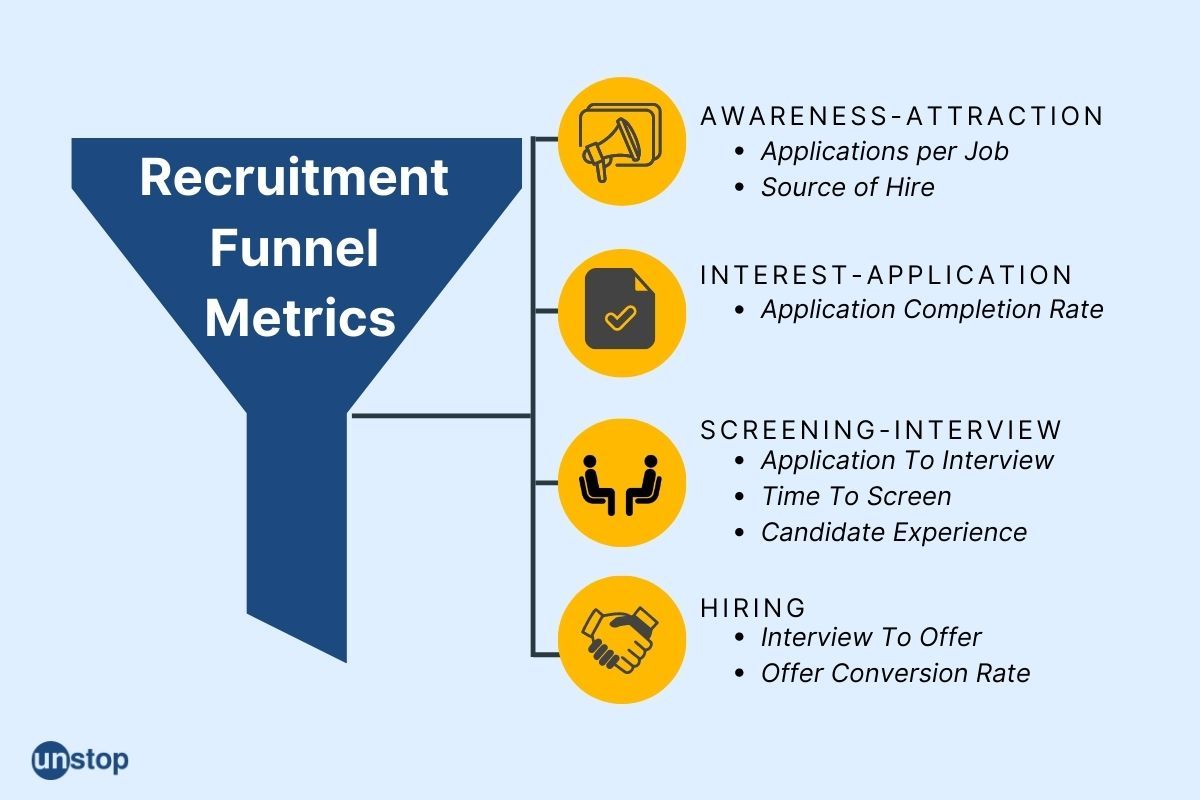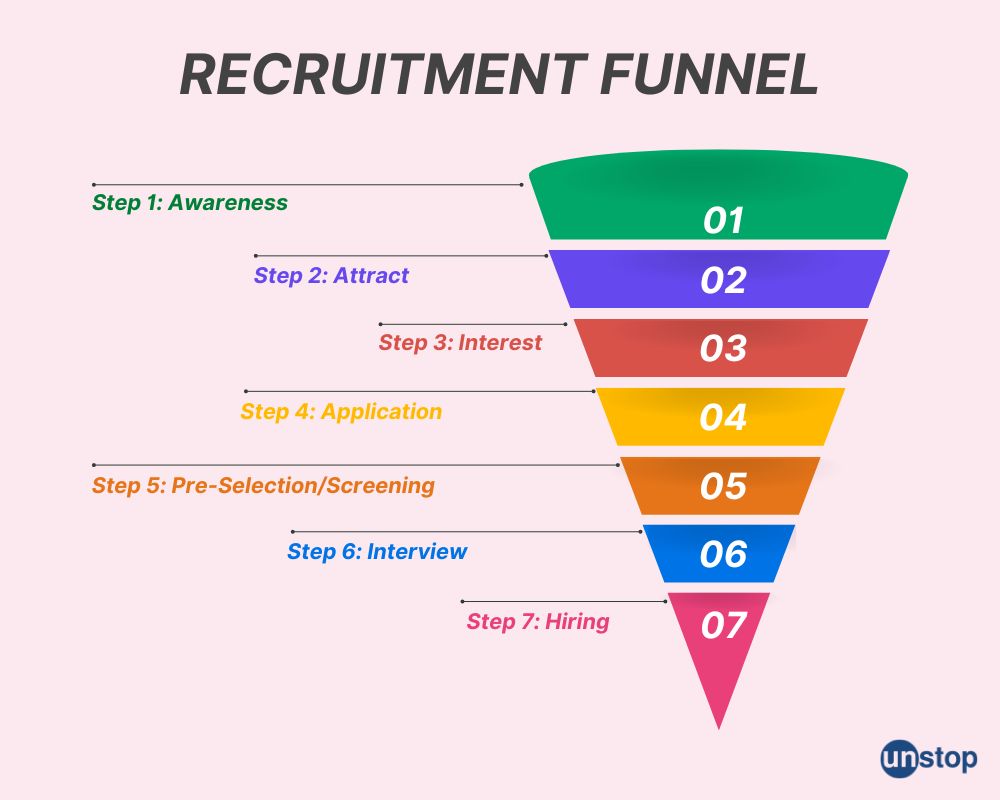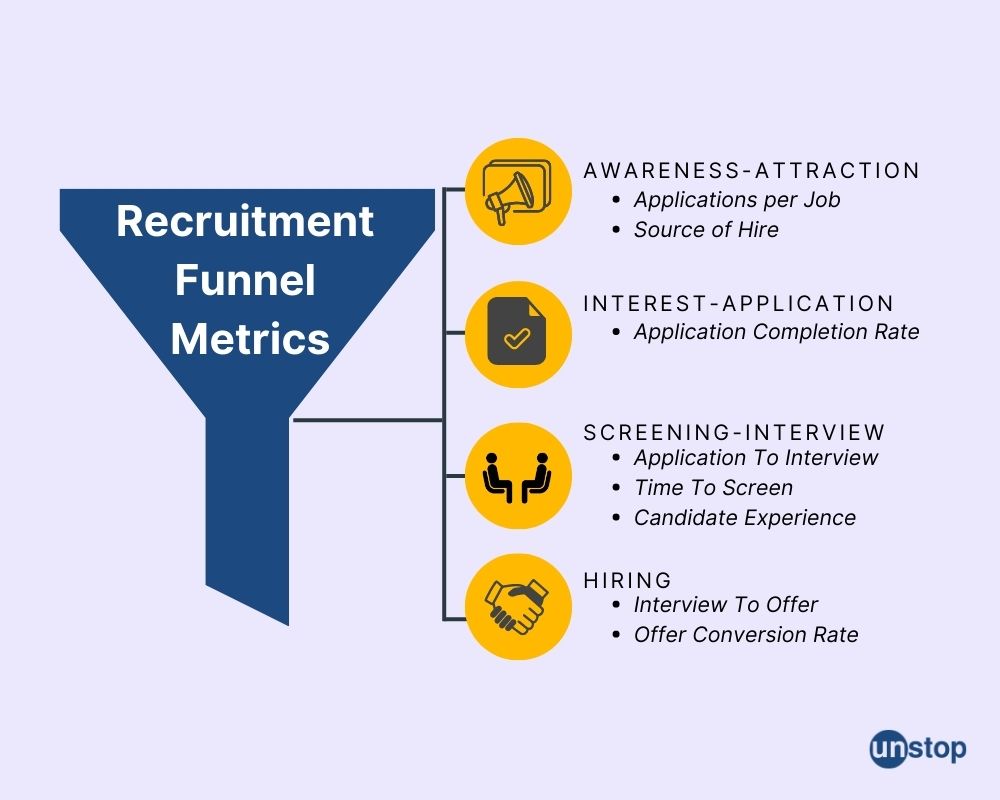- What's A Recruitment Funnel?
- Stages Of Recruitment Funnel
- Recruitment Funnel Metrics For Every Stage
- Frequently Asked Questions
Understanding Recruitment Funnel Metrics: The Perfect Approach To Measuring Effectiveness Of Hiring

The talent acquisition team or human resources department is responsible for several critical functions, including sourcing good candidates and hiring them timely, building a positive company culture, engaging the workforce, and retaining talented employees.
Similar to other departments in an organization, hiring teams also use tools and frameworks to improve their functioning. One such tool is a recruitment funnel. A recruitment funnel helps streamline the recruitment process. Organizations utilize various metrics to measure the effectiveness of the recruitment or hiring funnel and improve further.
In this detailed guide on recruitment funnel metrics, we'll take a look at what's a recruitment funnel, why is it important to track its effectiveness, and the relevant metrics for each stage of the funnel.
What's A Recruitment Funnel?
A recruitment funnel is a visual tool that helps organizations plan the different stages of talent acquisition. It offers a birds-eye view of the entire recruitment process - right from the time brand awareness is created (to attract quality applicants) to the time a candidate is hired.
The term comes from the concept of marketing funnel - a process companies use to convert potential customers into paying customers. Similarly, a recruitment funnel is a process for companies to convert potential candidates into working employees.
The hiring funnel is an effective tool for streamlining the recruitment process and has several advantages:
- It offers a visual aid for every stage of the process
- It allows organizations to identify the target candidate pool
- It helps minimized and even eliminate recruitment bias
- It helps organizations develop a strategic and tailored approach for candidate outreach and selection
Why Track A Recruitment Funnel?
A recruitment funnel, also referred to as a talent pipeline, is a framework that organizations adopt to streamline and improve their hiring process, from beginning to end. However, an approach is only good as the results it generated. A framework or tool that doesn't yield the appropriate results or fails more time than it succeeds is in need of rework.
This is exactly why we need to track a recruitment/hiring funnel and measure its effectiveness using recruitment funnel metrics. For every stage of a recruitment funnel, there are different metrics on which data can be collected and analyzed to find the bottleneck in the hiring process and/or areas of improvement.
Explore here if you're looking for faster and better ways to hire the right talent.
Before we dig deeper into recruitment funnel metrics, let's first understand the stages of the recruitment funnel.

Stages Of Recruitment Funnel

Organizations can expand or contract the recruitment funnel as per their need and recruitment process. However, broadly, a recruitment funnel goes through the following stages:
Awareness
Even before companies begin to source potential candidates, they need to build brand awareness. Thus, employer branding or creating awareness is the first stage of the funnel. At this stage, the goal is to ensure job seekers are aware of what the organization does, and the role it's looking to hire. This is an ongoing activity, and various communication channels, from career fairs to social media help organizations build brand awareness. When building awareness, don't just focus on the target pool for a specific role, but rather, on the larger audience - because you may be hiring for different roles at different times.
If organizations have limited recollection value or a negative brand image, it can get significantly difficult to source quality candidates for the role. Thus, building brand awareness is not a time-bound activity. In other words, don't just amp up brand-building activities when a new role is announced - work continuously to improve brand awareness and build a culture that potential candidates, at any time of the year.
Pro Tip: Use videos featuring current employees to share a glimpse of the company culture - especially in the case of virtual hiring.
Attraction
It's not enough for potential candidates to simply be aware of your company and the job posting. They also need to apply for the role! This is where attraction comes in.
At this stage, organizations need to attract potential candidates through well-crafted job descriptions with clear job titles and strategic ads. Job description plays a crucial role in attracting high quality candidates. Thus, organizations should ensure they clearly state the job requirements, optimize the language for SEO, and provide clear instructions about the application process and timelines. Hiring managers should also strategically select the job boards and other channels for sourcing candidates so that they reach out to the target audience.
Pro-Tip: Use employee referrals/referral programs to attract better quality, or even passive canddiates.
Interest
This is the third stage of the funnel. At this stage, candidates demonstrate their interest in the role - and may reach out to the organisation/hiring managers with queries or concerns. It's essential that companies provide prompt and clear responses. Remember, a candidate has expressed an interest in the role - but not yet applied for it. The way you interact with candidates is also a representation or indication of the company culture. Thus, be polite, prompt and helpful and build on the candidates' interest.
Pro Tip: Use chatbots for interactively answering frequently asked questions or clearly state FAQs on the company career page.
Application
At the application stage, candidates start applying for the role. Organizations must ensure that the application process is not long-drawn or cumbersome. One of the most common complaints, and a major barrier in attracting top talent, is a lengthy application form or complicated application process. Candidates may lose interest midway, and give up on the idea of applying altogether.
Pro-Tip: Make it easier to apply for a role by devising a simple process and using different tools. For example, enable auto-fill to reduce the time taken to fill the form.
Another thing to keep in mind at this stage is transparent communication. Inform candidates about the next steps after filling out the application form, and establish clear timelines. An applicant should not be forced to unnecessarily follow up for updates. Let them know the average time it will take to confirm their application is shortlisted for the next stage, and how should they proceed further. This can go a long way in building a positive candidate experience.
Pro-Tip: Ensure that the application is easily accessible via mobile devices as well, and can be filled out on a smartphone. It has become the go-to device for the younger generation for all activities, including applying for a job.
Pre-Selection/Screening
Once you have a ready pool of candidates, it's time to assess and shortlist. This is the screening process.
Organizations may opt for various screening and assessment tools, such as filtering resumes for basic skills, conducting skill-based assessment exercises to weed out unqualified applicants, aptitude tests, etc.
It's essential that organizations develop a comprehensive assessment framework, accurately mapped to the job requirements so only qualified candidates make it to the interview stage.
Find a range of assessment tools to measure skills and evaluate personality traits here.
Interview
The second-last stage in the funnel is the interview. Qualified applicants shortlisted after the screening stage are interviewed to further test their suitability for the role and the organization. The interview may be divided into different rounds (like the technical and HR round). Or a single interview may involve a panel of people from different departments. A combination of both is also possible.
Ideally, organizations should set basic guidelines for conducting interviews. By doing so organizations can account for unconscious bias (for example, using a diverse panel), while comprehensively assessing a candidate's technical and soft skills.
Hiring
This is the last and final stage of the funnel where successful candidates are made an offer and given time to accept or reject it.
At this stage, the hiring team has found the perfect candidate for the role and is ready to make them an offer. Thus, companies must make a competitive offer, that fairly values the candidates and matches the industry benchmark. A mismanaged or delayed offer may impact the chances of candidates accepting the offer.
This stage may include additional steps, such as conducting a background check and drafting the onboarding process. The onboarding process should include training programs and policies that can help new employees fit in with the company.
In certain cases, one or more of these stages may be combined into one - for example, attraction and interest, collectively, can be grouped under sourcing candidates. The stages are directly linked to the organization's recruitment process and the level of detail required by the talent acquisition team. Irrespective of the stages, an effective recruitment funnel is one that helps streamline the process to save time and money and boost the quality of hire.
Recruitment Funnel Metrics For Every Stage
Recruitment metrics are the various parameters on which data is collected and analyzed. Each metric should have a basic threshold that companies must meet.
The four most important metrics used to evaluate the overall hiring process are:
- Time to Hire
This metric calculates the total time it takes from the time applications are received for a role, to the time a hiring decision is made and offer is accepted by the successful candidate. This gives the hiring team an idea of the average time taken to fill a role. If a new role takes more time than the norm, it could be because it's a difficult-to-fill role, there is a flaw in the recruitment strategy or another reason. By identifying the source of delay, the TA team can come up with solutions. It also helps organizations determine the time taken to hire new candidates and replace exiting employees.
Time-to-Fill is a broader metric, which calculates the time taken from the time the company decides to hire for a role, to the time the position is filled. This metric is more appropriate to calculate the overall effectiveness of the recruitment funnel - from awareness to hiring.
- Cost per Hire
This includes the total cost (external costs and internal costs) or expense incurred for hiring. Among other activities, it includes the advertisement cost for promoting the role, the cost of assessing and interviewing candidates, making offers, and onboarding new hires. This data gives the average cost of hiring for a role. The hiring team tries tracks this data to better plan the budget for recruitment activities.
- Quality of Hire
This measures the quality of candidates hired for the role i.e., how well are they performing in the role. A candidate's level of performance can be measured on various parameters, depending on the role. For example, monthly targets for a sales executive; search traffic for an SEO manager, etc. This metric is especially important for hiring managers to evaluate if new hires are fitting in and have the resources to do their job well. It also highlights if there's a gap in the recruiting process, that is leading to mishires.
- Effectiveness of Funnel
This is a metric specific to measuring the effectiveness of the recruitment funnel. It evaluates every stage of the funnel by dividing the total number of applicants at a stage, with the total number of applicants who entered the funnel. If a particular has a significant drop-off in the number of candidates, then that's the problem area.
Stage-wise recruitment metrics:

Apart from the aforementioned metrics, there are specific recruitment funnel metrics for each stage. These are:
Stage: Awareness-Attraction
Metric: Applications per Job & Source of Hire
What it measures: Applications per Job track the number of applications a particular role receives. If the number is lower than the industry norm, then there is low awareness about the role and company. If the number is lower than the company average, then there is something missing in the job description - failing to attract candidates.
Source of Hire measures the number of applications received from different recruiting sources, allowing organizations to understand which channel gets the maximum interest, as well as the quality of candidates sourced from each channel. Consequently, you can direct your marketing efforts to channels that deliver the best result (in terms of both, quantity and quality of candidates).
Stage: Interest-Application
Metric: Application Completion Rate
What it measures: It shows how many applicants actually completed the application process, from the total number of applicants who expressed an interest in the role. A significant drop at this stage shows that the application is a lengthy process, or too complicated. The entire process should ideally be streamlined to make it more efficient i.e., requiring minimal effort from candidates.
Stage: Screening
Metric: Application to Interview & Time to Screen
What it measures: Application to Interviews measures the candidates who pass the screening round and make it to the interview stage. It's an indication of how detailed and thorough are the screening and assessment tools.
Time to Screen tracks the overall time it takes for the TA team to screen and shortlist candidates for the next stage. If it takes longer than usual, then there is a need to overhaul the process, use automation, or hire additional manpower for screening.
Stage: Interview
Metric: Candidate Experience
What it measures: The candidate experience is determined by every stage, but the in-person interview has a significant impact on it. If the interviewer is not courteous of the candidate's time, misinformed, etc. then it can lead to a poor candidate experience. This may, in extreme cases, even generate negative word-of-mouth publicity and hamper recruiting efforts in the future.
Stage: Hiring
Metric: Interview to Offer & Offer Acceptance Rate
What it measures: Interview to Offer measures the number of candidates who pass the interview stage. If this is low, it indicates that screening is not effective and even unqualified candidates are making it to the interview stage.
The offer acceptance rate, also referred to as the offer conversion rate, measures the number of people who accepted the offer from the total number of people who received an offer. A low number indicates the offer is missing crucial elements or is not being made in a timely manner and recruitment efforts need to be made to fill the gap.
Note: Different metrics can be used to evaluate the performance and effectiveness of each stage of the funnel. This is not a comprehensive list. A single metric can be used to evaluate more than one stage as well. For example, Interview to Offer metric offers insights into three stages, the screening, the interview, and the hiring.
These are some of the most common recruitment metrics that organizations can use to evaluate their talent acquisition process. The final list of recruitment funnel metrics will depend on an organization's end goal and recruitment practices.
Frequently Asked Questions
i) How can we ensure the effectiveness of a recruiting funnel?
To test if you've built an efficient recruitment funnel, use relevant metrics to track data at various stages of the funnel. The funnel analysis in recruitment allows you to find the exact stage that requires improvement.
Here are some of the recruiting metrics that you can use at various stages:
- Application Per Job
- Source Of Hire
- Application Completion Ratio
- Application To Interview
- Time To Screen
- Candidate Experience
- Interview To Offer
- Offer Conversion Rate
ii) What are the most crucial recruiting metrics?
Every organization has different metrics to evaluate recruitment efforts. Some of the most important recruiting metrics are:
Time to Hire
Cost per Hire
Quality of Hire
Apart from these, Source of Hire, Candidate Experience, and Offer Conversion Rate are also important.
iii) What are the benefits of using a recruiting funnel?
Here are the major benefits of using a recruiting funnel:
- It offers a visual aid for every stage of the process
- It allows organizations to identify the target candidate pool
- It helps minimized and even eliminate recruitment bias
- It helps organizations develop a strategic and tailored approach for candidate outreach and selection
Ultimately, a funnel approach helps make recruitment a more effective process - one that saves time and money, redirects recruiting efforts to more appropriate channels, and improves the quality of hires.
Suggested Reads:
I’m a reader first and a writer second, constantly diving into the world of content. If I’m not writing or reading, I like watching movies and dreaming of a life by the beach.
Login to continue reading
And access exclusive content, personalized recommendations, and career-boosting opportunities.
Subscribe
to our newsletter
Blogs you need to hog!

Organize Hackathons: The Ultimate Playbook With Past Case Studies

What is Campus Recruitment? How To Tap The Untapped Talent?

Lateral Hiring: A Complete Guide To The Process, Its Benefits, Challenges & Best Practices













Comments
Add comment